Instant Park
 Wednesday, July 1, 2009 at 3:59PM
Wednesday, July 1, 2009 at 3:59PM This project is an original design concept developed during my first year of graduate studies in the Project Architecture and Engineering Program (PAE) at Steven’s Institute of Technology.
Concept
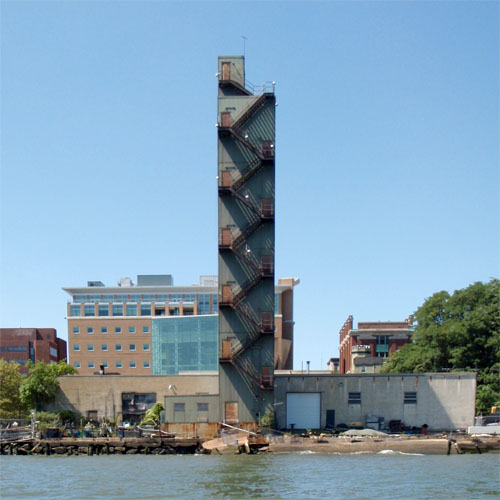 One of the core ideas of PAE is the notion that it is possible to develop “generic” responses to specific architectural conditions. This project engages that idea in an extensive set of exercises geared toward product development. Instant Park was originally conceived as a response to a specific industrial waterfront site in Hoboken but is applicable to any “generic” industrial site, of which New York City has many. The creation of a park from a former industrial site is a time-consuming, laborious and multifaceted process. My core idea was to develop an architectural component which would allow use of a site in isolation from those conditions.
One of the core ideas of PAE is the notion that it is possible to develop “generic” responses to specific architectural conditions. This project engages that idea in an extensive set of exercises geared toward product development. Instant Park was originally conceived as a response to a specific industrial waterfront site in Hoboken but is applicable to any “generic” industrial site, of which New York City has many. The creation of a park from a former industrial site is a time-consuming, laborious and multifaceted process. My core idea was to develop an architectural component which would allow use of a site in isolation from those conditions.
Instant Park Tile is an architectural component to be sold or rented to a  municipality, non-profit or other organization, to be used in the creation of a minimal infrastructure for the maximal use of a site while planning and construction are underway. This product is to be reconfigurable to accommodate any site and any potential form from playground to pavilion, furniture to fountain. Redeployment at the site itself should be considered as a core conceit to allow for use during a phased-construction schedule. An additional concern for Instant Park Tile is that it be an economically viable option for non-profit groups to deploy in the use of specific public programs, such as boating, within public parks. In many instances, requests to host such programs is denied due to a lack of inexpensive infrastructure (buildings and other facilities) which meet the criteria of the municipality or governing body often for aesthetic but also safety and maintenance concerns.
municipality, non-profit or other organization, to be used in the creation of a minimal infrastructure for the maximal use of a site while planning and construction are underway. This product is to be reconfigurable to accommodate any site and any potential form from playground to pavilion, furniture to fountain. Redeployment at the site itself should be considered as a core conceit to allow for use during a phased-construction schedule. An additional concern for Instant Park Tile is that it be an economically viable option for non-profit groups to deploy in the use of specific public programs, such as boating, within public parks. In many instances, requests to host such programs is denied due to a lack of inexpensive infrastructure (buildings and other facilities) which meet the criteria of the municipality or governing body often for aesthetic but also safety and maintenance concerns.
Initial Sketches
 The early concept sketches were for a deployment of roto-molded tiles and a minimal space-frame. These sketches were developed as parametric models in Catia, utilizing VB script and formula-driven geometry. The space-frame has been parametized as a set of cardiod-shaped profiles instantiated along a parabola. The result is a point cloud which is then utilized to instantiate the tiles. Multiple tile versions were used to generate both renderings and the physical model.
The early concept sketches were for a deployment of roto-molded tiles and a minimal space-frame. These sketches were developed as parametric models in Catia, utilizing VB script and formula-driven geometry. The space-frame has been parametized as a set of cardiod-shaped profiles instantiated along a parabola. The result is a point cloud which is then utilized to instantiate the tiles. Multiple tile versions were used to generate both renderings and the physical model.
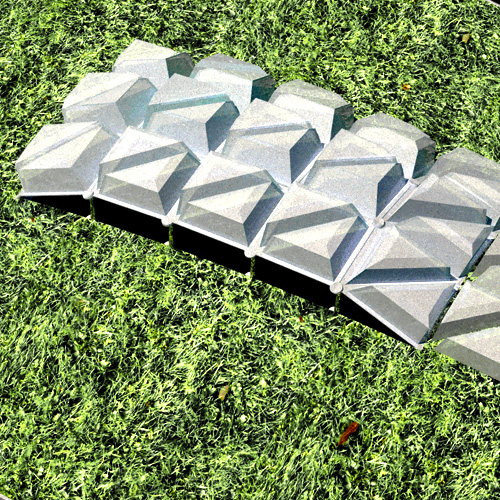 The completion of the initial sketch pointed out new areas to investigation. To be viable from a fabrication standpoint, the tiles need to be in as few variations as possible but the sketch contained a dozen or more variations. The “landscape” model, shown here, was a first response to develop a simpler set of tiles and configurations.
The completion of the initial sketch pointed out new areas to investigation. To be viable from a fabrication standpoint, the tiles need to be in as few variations as possible but the sketch contained a dozen or more variations. The “landscape” model, shown here, was a first response to develop a simpler set of tiles and configurations.
Tile Development
 Since the tile was to be the driver of my overall system I began by making a few paper models of tiles to look at the implicit behavior. Based upon the paper model, I developed a digital model in Generative Components. While developing the GC model, I realized that the ultimate limit of the component was the relationship between the triangles sub-components, the self-intersection. Further, the “quad” and “double” triangle tiles were less than optimal and would require huge amounts of variation even if molded parametrically.
Since the tile was to be the driver of my overall system I began by making a few paper models of tiles to look at the implicit behavior. Based upon the paper model, I developed a digital model in Generative Components. While developing the GC model, I realized that the ultimate limit of the component was the relationship between the triangles sub-components, the self-intersection. Further, the “quad” and “double” triangle tiles were less than optimal and would require huge amounts of variation even if molded parametrically.
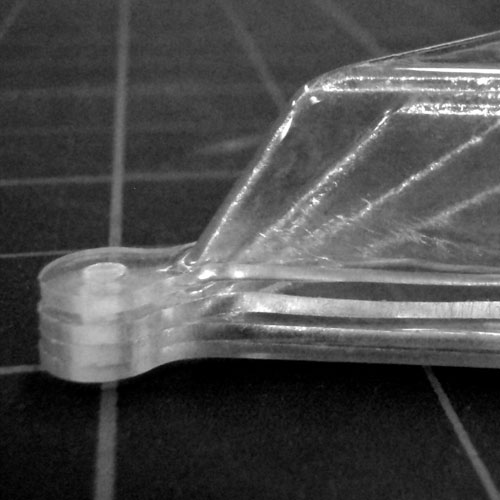 Ultimately, I developed a set of four triangle tiles, based on a 45/45/90 triangle, whose only difference was the draft angle of the volumetric extrusion. Male-molds were created on a CNC mill and used in the creation of a vacuum-formed plastic tiles. During the process access to the vacuum forming facility fell through so I designed and built a vacuum table. The tiles were formed of PETG, a recyclable plastic, and then returned to the mill for trimming. The PETG allowed me to configure tiles into various assemblies and manipulate them by heating the nodal connection tabs selectively.
Ultimately, I developed a set of four triangle tiles, based on a 45/45/90 triangle, whose only difference was the draft angle of the volumetric extrusion. Male-molds were created on a CNC mill and used in the creation of a vacuum-formed plastic tiles. During the process access to the vacuum forming facility fell through so I designed and built a vacuum table. The tiles were formed of PETG, a recyclable plastic, and then returned to the mill for trimming. The PETG allowed me to configure tiles into various assemblies and manipulate them by heating the nodal connection tabs selectively.
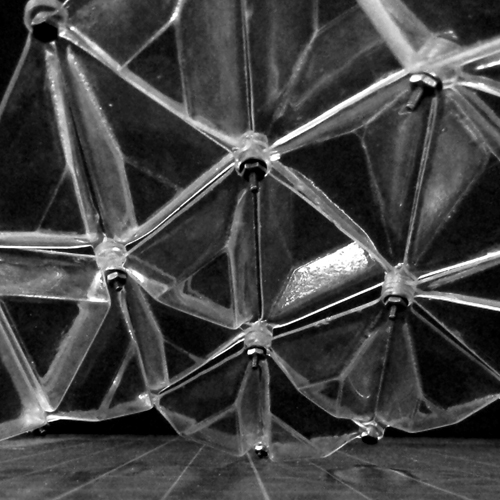 What became apparent from interacting with the tiles was that a huge variety of shapes were possible based upon adjusting one parameter, the draft angle. What also became obvious was that none of the digital models I had created to date could predict or simulate the assembly of the components. To do so, I took two approaches.
What became apparent from interacting with the tiles was that a huge variety of shapes were possible based upon adjusting one parameter, the draft angle. What also became obvious was that none of the digital models I had created to date could predict or simulate the assembly of the components. To do so, I took two approaches.
Optimization as Form-Finding
 One aspect of the plastic tile model was that its overall behavior was like that of fabric. Depending on the arraignment of the tiles an entire sheet would exhibit a uniform shape or would become ”kinked” and unable to move in certain directions. There was an inherent “bias” to the arraignments which allowed for certain shapes to emerge. I decided to investigate Optimization as a means to find what the implicit limits of the system were. I created a number of models where I arranged triangles in specific configurations and, utilizing a simulated-annealing algorithm, asked the Optimizer to “find” a form in relationship to a target point or surface.
One aspect of the plastic tile model was that its overall behavior was like that of fabric. Depending on the arraignment of the tiles an entire sheet would exhibit a uniform shape or would become ”kinked” and unable to move in certain directions. There was an inherent “bias” to the arraignments which allowed for certain shapes to emerge. I decided to investigate Optimization as a means to find what the implicit limits of the system were. I created a number of models where I arranged triangles in specific configurations and, utilizing a simulated-annealing algorithm, asked the Optimizer to “find” a form in relationship to a target point or surface.
Rhinoscript
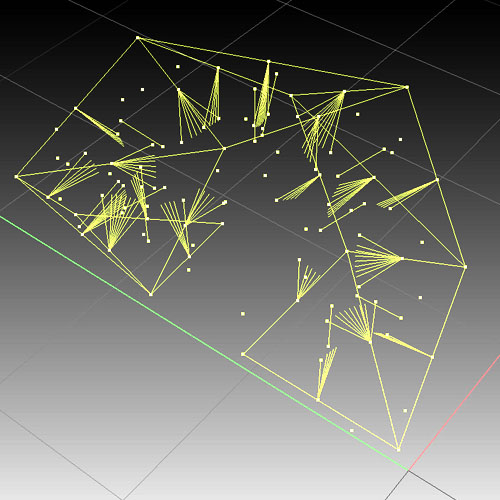 The primary result of the optimization models was the realization that nodal connections between the tiles were overly restrictive and inflexible. A more appropriate relationship would be obtained at the face-to-face connections allowing for some tolerance in the assembly. Based upon the face-to-face logic of the tiles have I begun to create a script-based approach to investigate the use of a population algorithm to “discover” novel tile-to-tile assemblies.
The primary result of the optimization models was the realization that nodal connections between the tiles were overly restrictive and inflexible. A more appropriate relationship would be obtained at the face-to-face connections allowing for some tolerance in the assembly. Based upon the face-to-face logic of the tiles have I begun to create a script-based approach to investigate the use of a population algorithm to “discover” novel tile-to-tile assemblies.
Tile Evolution
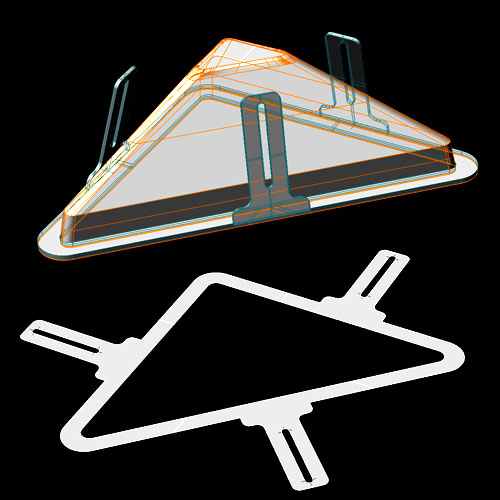 Both digital-assembly models indicated that an evolution of the tile component was warranted. The switch to a face-to-face connection logic proved fruitful in that not only was it possible to reduce the formed tile to a single mold but a simple structural flange could be created which would be based upon a single component that could be bent to accommodate any required angle.
Both digital-assembly models indicated that an evolution of the tile component was warranted. The switch to a face-to-face connection logic proved fruitful in that not only was it possible to reduce the formed tile to a single mold but a simple structural flange could be created which would be based upon a single component that could be bent to accommodate any required angle.
Next Steps
The completion of a 1:1 or 1:2 scale tile is well within reason and if further development takes place that will be one of the first tasks. The second order of business is to return to the digital assembly models and investigate the potential of the new tile assembly with new angular limits. While the current tile evolution has made fabrication as simple as can be imagined the component itself seems to be optimized to roof or surface covering and less so for additional uses such as furniture or playground apparatus.
 Bill | Comments Off |
Bill | Comments Off | 